Operation Anaconda took place in Afghanistan from 1 to 18 March 2002. It was a large-scale international military campaign led by the United States aiming at the destruction of Al Qaeda and Taliban forces. A particular intense battle took place during the morning hours (before dawn) of 4 March on Takur Ghar, a 3191 meter high mountain top, as US Special Operations Forces came under heavy fire from the Al Qaeda and Taliban forces. A Chinook helicopter was directed to rescue the team. However, in view of the rocket-propelled grenades and heavy machine guns that the insurgents were using, a SATCOM (Satellite Communications) message was sent to the Chinook to avoid the mountain top. Unfortunately and despite repeated attempts, the Chinook helicopter never received that critical message. It landed on the top of Takur Ghar and came immediately under intense fire, resulting in several casualties.
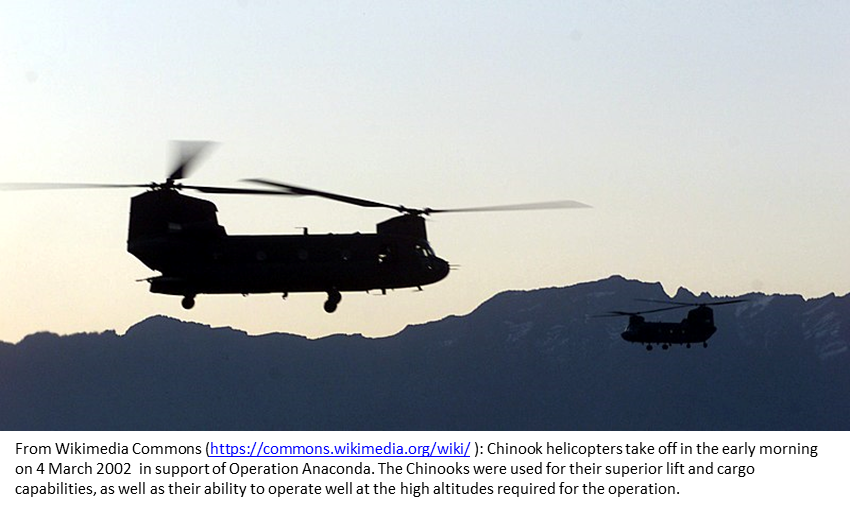
A subsequent analysis of the incident blamed the radio outage on poor performance of the UHF (Ultra High Frequency) radios on the helicopters as well as on terrain radio interference. However, in 2014, Michael Kelly and his team of researchers from the John Hopkins University came to a different conclusion, offering a viable alternative for the outages. Utilizing a model that uses UV (ultraviolet) data from the TIMED spacecraft to retrieve the 3D electron density, they came to the conclusion that a combination of ionospheric disturbances with multipath effects (multiple radio reflections from the mountainous terrain) could also have caused the decreased communication links.
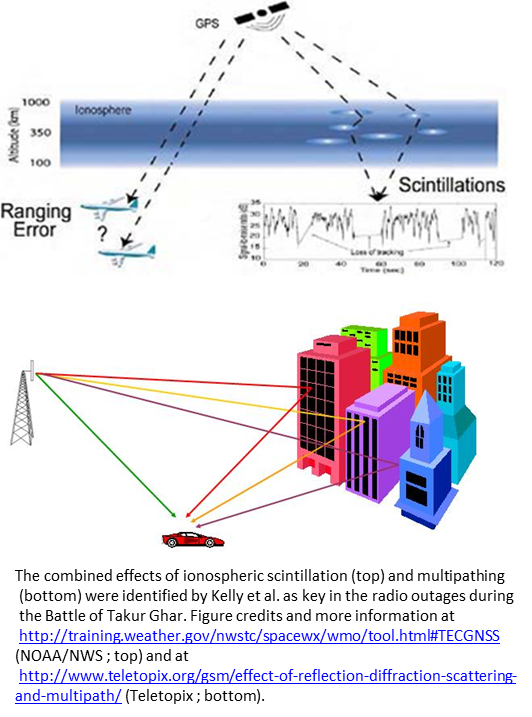
The main cause of the ionospheric unrest is the presence of equatorial plasma bubbles, i.e. depletions of electron density in the ionosphere. Their number correlates with the solar activity level, and they also are more numerous during the equinoxes (spring and autumn) than during the solstices (summer and winter). They usually form after sunset at the bottom of the F-region (main ionospheric layer), where small low-density irregularities can grow into turbulent bubbles - see a model underneath (covering 40 minutes) developed by Dr Yokoyama (NICT/AERI). The bubbles have a typical size of about 100 km and their effects usually end around midnight. They can occur during relatively minor levels of geomagnetic activity, especially during solar maximum. Radio wave propagation can be severely affected in terms of power and intensity as these waves travel through small scale structures in the ionosphere (i.e. scintillation of radio waves).
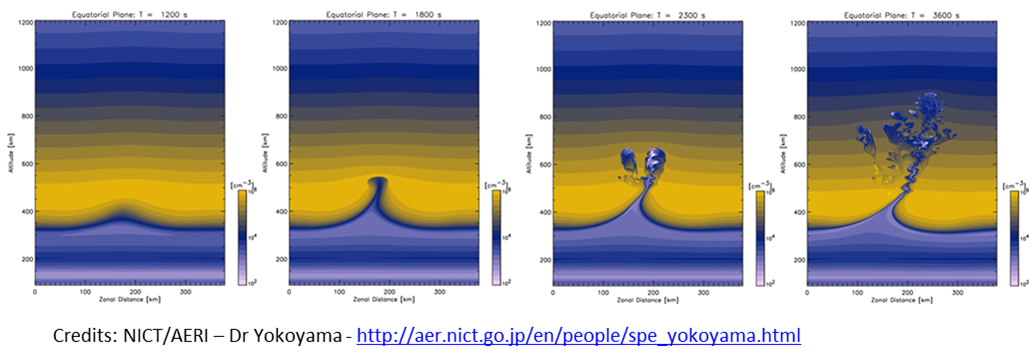
At first sight, one would expect relatively strong geomagnetic activity to explain the ionospheric disturbances, but this was not the case on 3-4 March. Quiet to unsettled geomagnetic conditions were observed, with a single active episode during the 21-24UT interval on 3 March. According to Kelly et al., this suppressed the generation of the evening-side depletions and delayed the onset of the ionospheric bubbles until after midnight.
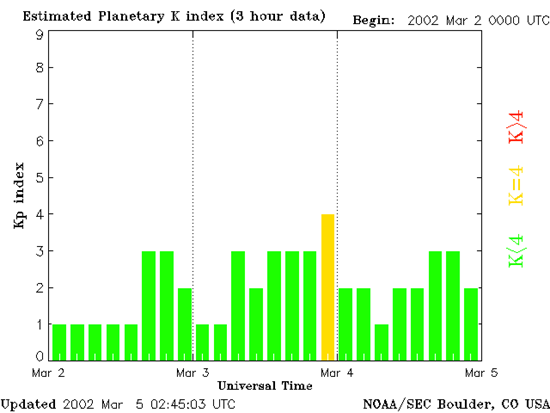
However, analysis of the data from the TIMED satellite led Kelly and his team to conclude that the plasma bubbles affecting the Takur Ghar war theatre did not have very steep density gradients, and thus would have resulted only in mild ionospheric disturbances. Normally, this mild ionospheric "scintillation" is not a problem for SATCOM, but the intensity of the already weakened radio signals could have further been reduced by the multiple reflections from the surrounding mountains. Hence they conclude that "... the destructive multipath interference from complex terrain reflections coupled with scintillation could cause a signal blackout. ..."
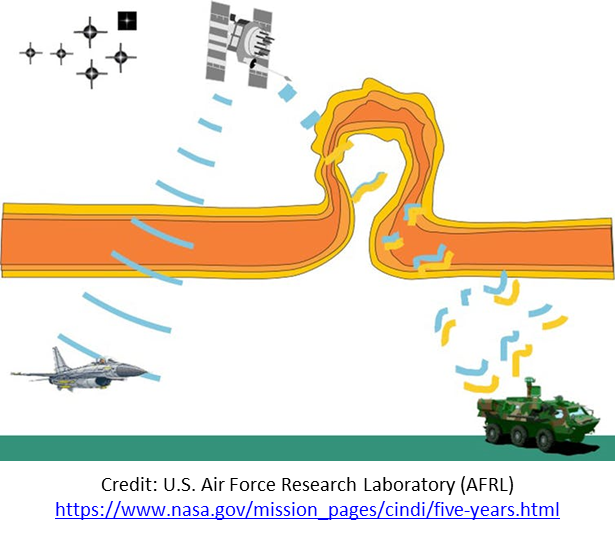
Several important lessons can be learned from the incident and the related research by Kelly and his team. Ionospheric anomalies have the potential to disrupt communications during military operations, hence space-based ionospheric sensing is critical for accurate monitoring and forecasting of ionospheric effects on radio communications. These space weather anomalies have the potential to impact future operations at all times during the solar cycle, and even mild perturbations in combination with terrain interference or other sources can be sufficient to cause radio outages.
Further reading
- Kelly et al. (2014): Progress toward forecasting of space weather effects on UHF SATCOM after Operation Anaconda, http://adsabs.harvard.edu/abs/2014SpWea..12..601K
- The Conversation (2014): Bad space weather may have caused fatal Afghan gun battle, https://theconversation.com/bad-space-weather-may-have-caused-fatal-afghan-gun-battle-32081
- NASA/GSFC (2013): Celebrating NASA's CINDI on Its Fifth Anniversary, https://www.nasa.gov/mission_pages/cindi/five-years.html
- Yokoyama et al. (NICT/AERI): Observation and modeling of "ionosphere": the entrance to space, http://aer.nict.go.jp/en/people/spe_yokoyama.html
- A sketch showing the combined effect of ionospheric scintillations and multipathing was prepared by Dr Nicolas Bergeot (ROB / GNSS).
Ionospheric research and products at the STCE
- ROB / GNSS: http://gnss.be/Atmospheric_Maps/ionospheric_maps.php
- RMI / Dourbes: http://digisonde.oma.be/
- BISA: http://www.aeronomie.be/en/topics/earthsystem/ionosphere.htm





